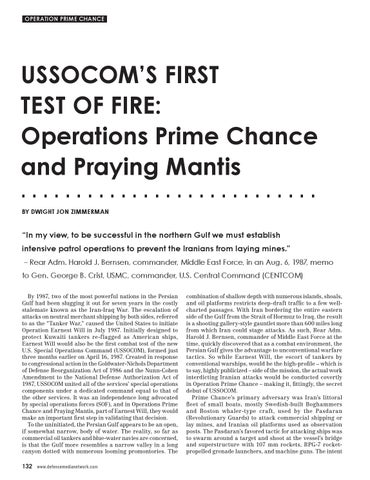operation PRIME CHANCE
USSOCOM’S FIRST TEST OF FIRE: Operations Prime Chance and Praying Mantis By Dwight Jon Zimmerman
“In my view, to be successful in the northern Gulf we must establish intensive patrol operations to prevent the Iranians from laying mines.” – Rear Adm. Harold J. Bernsen, commander, Middle East Force, in an Aug. 6, 1987, memo to Gen. George B. Crist, USMC, commander, U.S. Central Command (CENTCOM) By 1987, two of the most powerful nations in the Persian Gulf had been slugging it out for seven years in the costly stalemate known as the Iran-Iraq War. The escalation of attacks on neutral merchant shipping by both sides, referred to as the “Tanker War,” caused the United States to initiate Operation Earnest Will in July 1987. Initially designed to protect Kuwaiti tankers re-flagged as American ships, Earnest Will would also be the first combat test of the new U.S. Special Operations Command (USSOCOM), formed just three months earlier on April 16, 1987. Created in response to congressional action in the Goldwater-Nichols Department of Defense Reorganization Act of 1986 and the Nunn-Cohen Amendment to the National Defense Authorization Act of 1987, USSOCOM united all of the services’ special operations components under a dedicated command equal to that of the other services. It was an independence long advocated by special operations forces (SOF), and in Operations Prime Chance and Praying Mantis, part of Earnest Will, they would make an important first step in validating that decision. To the uninitiated, the Persian Gulf appears to be an open, if somewhat narrow, body of water. The reality, so far as commercial oil tankers and blue-water navies are concerned, is that the Gulf more resembles a narrow valley in a long canyon dotted with numerous looming promontories. The
132
www.defensemedianetwork.com
combination of shallow depth with numerous islands, shoals, and oil platforms restricts deep-draft traffic to a few wellcharted passages. With Iran bordering the entire eastern side of the Gulf from the Strait of Hormuz to Iraq, the result is a shooting gallery-style gauntlet more than 600 miles long from which Iran could stage attacks. As such, Rear Adm. Harold J. Bernsen, commander of Middle East Force at the time, quickly discovered that as a combat environment, the Persian Gulf gives the advantage to unconventional warfare tactics. So while Earnest Will, the escort of tankers by conventional warships, would be the high-profile – which is to say, highly publicized – side of the mission, the actual work interdicting Iranian attacks would be conducted covertly in Operation Prime Chance – making it, fittingly, the secret debut of USSOCOM. Prime Chance’s primary adversary was Iran’s littoral fleet of small boats, mostly Swedish-built Boghammers and Boston whaler-type craft, used by the Pasdaran (Revolutionary Guards) to attack commercial shipping or lay mines, and Iranian oil platforms used as observation posts. The Pasdaran’s favored tactic for attacking ships was to swarm around a target and shoot at the vessel’s bridge and superstructure with 107 mm rockets, RPG-7 rocketpropelled grenade launchers, and machine guns. The intent
